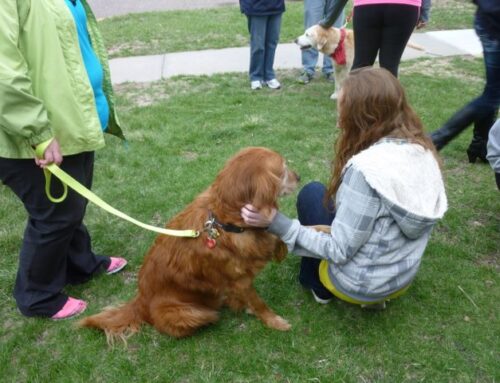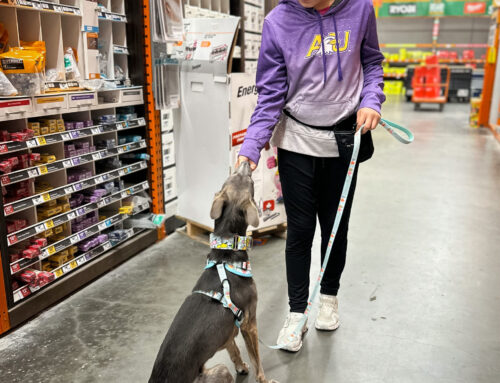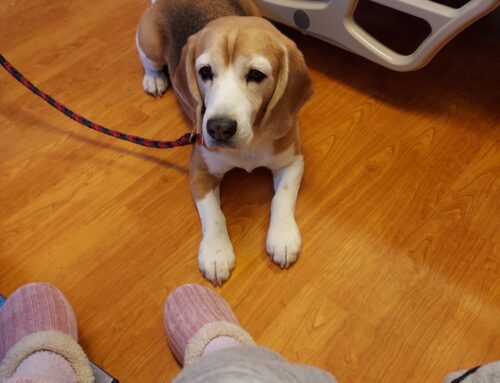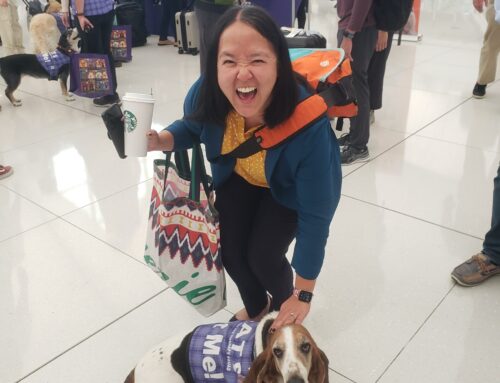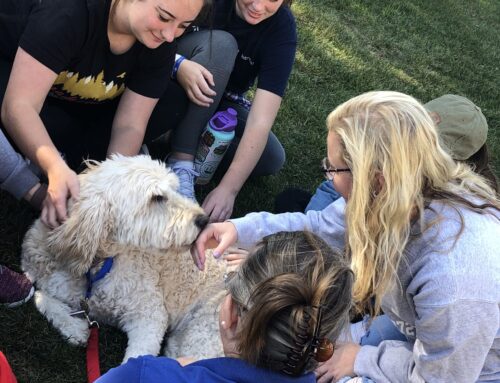The Alliance of Therapy Dogs, the premier therapy dog organization in the United States, knows that Halloween can be a festive and fun time for children and families. We also know that Halloween can be a nightmare for dogs. Strangers in costumes knocking on doors and ringing doorbells are cause for alarm in most dogs as they go into “protection mode.” Aside from the stress it may cause, there are other potential dangers lurking on October 31st. In this article, we will offer tips to keep your pets safe during Halloween. It is important to note that ALL of the dangers presented in this article are preventable.
How Can I Keep My Dog Safe This Halloween?
Keep the trick-or-treat candy away from your dog. Candy is meant to attract, and it does. Candy is not good for dogs, and some candies can actually be lethal. Many Halloween candies containing the artificial sweetener xylitol that can be poisonous to dogs. Xylitol can cause a sudden drop in blood sugar as well as a subsequent loss of coordination and seizures. Some common candy dangers for pets include:
- Wrappers, string, and sticks that accompany candy may cause a blockage that requires medical attention.
- Fatty chocolate and candies can also predispose dogs to pancreatitis.
- Raisins can cause death in dogs, and many nuts are also dangerous if ingested.
- Chocolate — especially baking or dark chocolate — can be dangerous and even lethal for dogs. Symptoms of chocolate poisoning may include vomiting, diarrhea, rapid breathing, increased heart rate, and seizures.
The toxic component of chocolate is theobromine. Humans easily metabolize theobromine, but dogs process it much more slowly allowing it to build up to toxic levels in their system. A large dog can consume more chocolate than a small dog before suffering ill effects. A small amount of chocolate will probably only give your dog an upset stomach with vomiting or diarrhea. With large amounts, theobromine can produce muscle tremors, seizures, an irregular heartbeat, internal bleeding or a heart attack. The onset of theobromine poisoning is usually marked by severe hyperactivity.
The usual treatment for theobromine poisoning is to induce vomiting within two hours of ingestion. If you are worried or suspect that your dog may have eaten a large quantity of chocolate and they are showing any of the signs listed above, call your veterinarian immediately. If you have a small dog that has eaten a box of chocolates, you need to call and go to your veterinarian right away. Do not wait. However, should your dog get ahold of a piece or two, it is most probably not cause for alarm.
Do not leave your dog outside on Halloween. Vicious pranksters have been known to tease, injure, steal, and even kill pets on Halloween night. Keep your pets safe inside the house.
Keep your dog confined and away from the door. People will be coming to the house on a semi-continual basis, including children dressed in unusual costumes with masks. The continually ringing doorbell or knocking, and the door’s constant opening and closing may upset pets. It is easy to see how a constant flow of visitors and noise can be stressful and confusing to a dog. Additionally, their protective instinct is and their reactions could range from fear and anxiety to aggression and escape attempts, which are more likely to be successful due to the frequently opening door. If you know your dog is nervous, keep them contained in a part of the house that is as far away as possible from the door to avoid holiday pet runaways.
Keep Halloween pumpkins and corn out of your dog’s reach. Although they are relatively nontoxic, these vegetables can induce gastrointestinal upset if ingested by your pet in large quantities. Intestinal blockage can even occur if they swallow large pieces of pumpkin or a corncob.
Do not leave lit pumpkins or electrical cords unattended around pets. Should your pets get too close, they run the risk of burning themselves or knocking the pumpkin over and causing a fire. If your dog chews on the cords, they could be cut on shards of glass or plastic, or receive a possibly life-threatening electric shock.
Be careful with pet costumes and try them on before Halloween. For some pets, wearing a costume can cause stress. The ASPCA and PetMD recommend not putting your dog in a costume unless you know they will be comfortable and stress-free. The costume should not limit your dog’s movement, sight, or ability to breathe, or bark. The costume should be checked over for small, dangling pieces that can easily be chewed off to ensure there are no choking hazards. Let your dog become acquainted and get used to the costume beforehand. If they show any sign of not liking the costume, let them go without it.
Keep your dog calm and easily identifiable. Halloween brings a flurry of activity with visitors arriving at the door, and too many strangers can often be scary and stressful for your pets. All but the most social dogs should be kept in a separate room away from the front door during peak trick-or-treating hours. While opening the door for guests, be sure that your dog doesn’t dart outside. Always make sure your pet is wearing proper identification—if for any reason he or she does escape, a collar with ID tags and/or a microchip can be a lifesaver for a lost pet. If your dog should escape and become lost, having the proper identification will increase the chances that they will be returned to you. Make sure the information is up-to-date, even if your pet has an embedded microchip.
Halloween is fun for you and your kids and, with a little planning and prevention, it can be fun for your four-legged kids as well. Should you have any questions regarding safeguarding your pets during Halloween or would like more information about therapy dogs, please contact the Alliance of Therapy Dogs.


